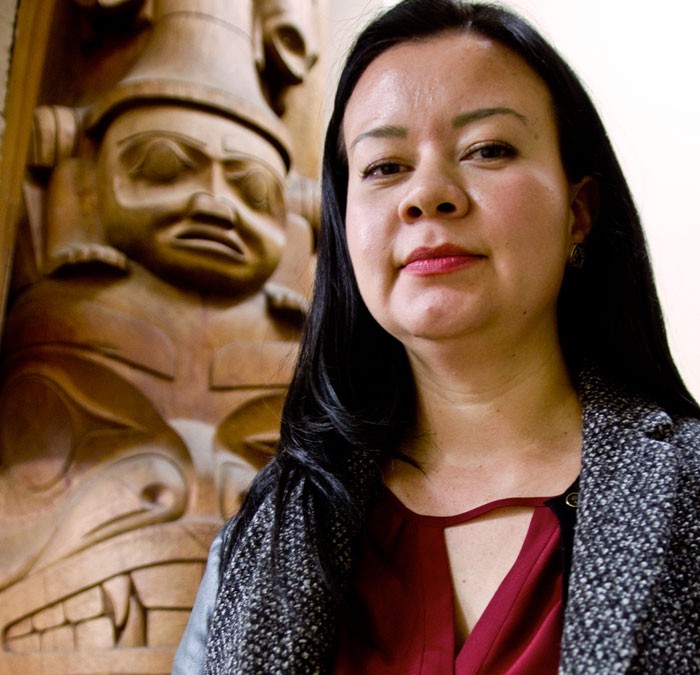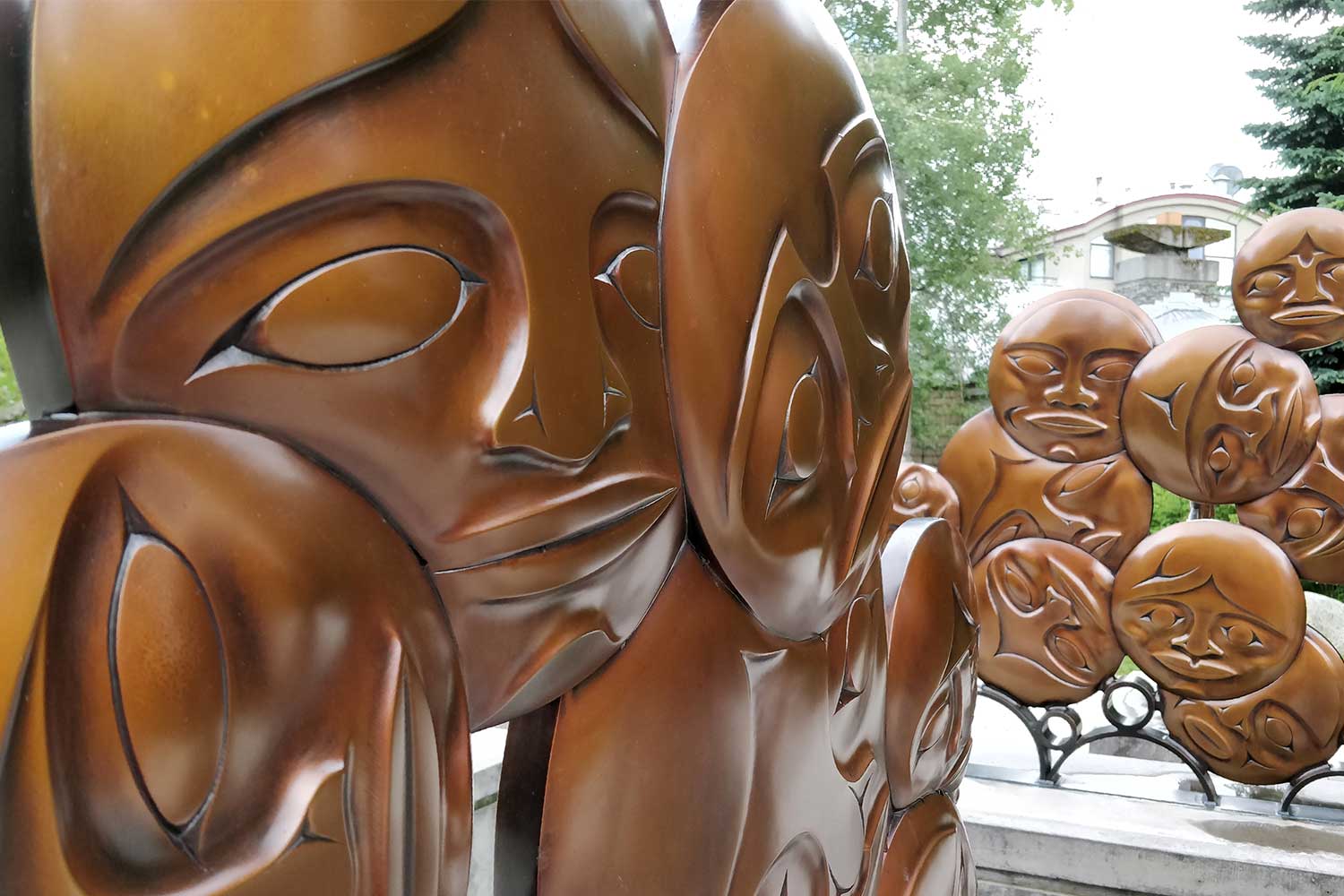Decolonizing the City: A Q&A with Ginger Gosnell Myers
Vancouver’s first Indigenous relations manager reflects on the urban Aboriginal experience.
Coast Salish artist Susan Point’s sculpture entitled Timeless Circle depicts the diversity of people living on Coast Salish territory, in the past, present, and future.
Ginger Gosnell-Myers is a Nisga’a citizen who also has Kwakwaka’wakw roots. Although her Indigenous identity is firmly rooted in the Nisga’a village of Gitlaxt’aamiks (just east of Alaska’s southern tip), she has called Vancouver home since 1998. In fact, Gosnell-Myers — whose Nisga’a name is Skusgluums — is one of over 60,000 Aboriginal people who make their home in Metro Vancouver, the third largest Indigenous population in Canada (behind Winnipeg and Edmonton).
From 2016–18, she worked as the City of Vancouver’s first Indigenous relations manager. Recently appointed as an Indigenous fellow at Simon Fraser University’s Morris J. Wosk Centre for Dialogue, she’ll be exploring decolonization and urban Indigenous planning. She hopes to advance the conversation about Indigenous people in the urban context by focusing on the path leading toward reconciliation, rather than on the final destination. This interview has been edited for length and clarity.
Wawmeesh Hamilton: Tell me a bit about where you grew up.
Ginger Gosnell-Myers: I grew up in my village of New Aiyansh — now called Gitlaxt’aamiks — and later in Prince Rupert. When I think about my childhood, I think about all the foods we have access to. And I think about our mountains and our lava beds. In the spring, it smells like cottonwood trees. In the winter it smells like crisp, clean air, with hints of smoke from people’s fireplaces.
When did you move to Vancouver and why?
I moved to the city as an adult in 1998, to go to school.

Ginger Gosnell-Myers has been appointed as the first Indigenous fellow at SFU’s Wosk Centre for Dialogue.
What does being urban Indigenous mean to you?
Being urban Indigenous — it’s not my Indigenous identity. It means that I choose to live in the city. I have access to the opportunities other urbanites have.
Can you describe what reconciliation is?
The Truth and Reconciliation Commission’s work really provided Canadians an opportunity to understand the abuse our relatives endured through the Indian residential schools system. And understanding the history has provided us this new concept of reconciliation. For me, and for the work that I did at the City of Vancouver, that meant understanding the harms caused by past government actions and inactions, and finding new ways to heal from that past.
Reconciliation with First Nations communities isn’t hard to grasp: you think about nation-to-nation relationships, territorial sovereignty, and clean drinking water, for instance. But what does it mean to Indigenous people in the city?
Urban Indigenous people still desire to be reflected in their workplaces, in the schools they attend, in the neighbourhoods they reside in. When I think about reconciliation for urban Indigenous people, it’s about not being invisible in these spaces.
Reconciliation for urban Indigenous people is about not being invisible.
What are some of the specific challenges that urban Indigenous people face?
Urban Indigenous people face the same issues any person or family living in the city would face. The jobs we have no longer pay enough to allow us to either rent or own a home. The cost of housing is pushing people out. It’s stopping Indigenous people from realizing the aspirations they have for a good life. This links to the poverty that so many Indigenous people are fighting to overcome. Poverty linked to years and years of government oppression that made it impossible for us to own a home, own the land, hire a lawyer to fight for our rights, to vote. All of these issues have marginalized our ability to seek a good life at the same level as other Canadians.
What questions are you most excited to explore in your new role at the Centre for Dialogue?
I’m focusing on decolonization and its relationship to urban Indigenous planning. The majority of Indigenous people live in urban centres, yet the focus has been on on-reserve matters. Or on issues like homelessness, addictions or suicide, but not on urban Indigenous communities as a whole.
These systems were developed ages ago — primarily by wealthy white men — to oppress everybody: women, young people, any person of colour.
We think of colonization as a thing of the past, but how present is it?
We still have an Indian Act that oversees how First Nations communities are governed and run. These governing institutions sit in large buildings in capital cities, and they don’t have any real connection to Indigenous peoples or communities. And yet, they have ultimate governing authority over our lives, our lands, and even the solutions we say need to be implemented.
Efforts for decolonization ensure that our ideas around governance, justice, and solutions are actually included in decision-making processes. I feel that our systems of governance at the federal, municipal, and provincial levels aren’t really working for anybody. That’s because these systems were developed ages ago — primarily by wealthy white men — to oppress everybody: women, young people, any person of colour. Our systems today were set up to benefit just a few. I feel like decolonization benefits everybody.
How do you begin to shift society away from colonialism?
It starts with Canadians understanding the real history of Canada’s treatment of Indigenous people, and the atrocities we had to overcome. I think when we look back at Canada’s creation, some historians may say that it was a time of great change and innovation, but for Indigenous people it was hell. It was a time of death, despair, oppression, sadness, and hurt. And we’re still dealing with these effects today. To overcome the impacts of colonialism, start with the truth.
We need to ask ourselves every day: “What can be done better?”, “Who is being excluded?”, “Who needs to be included?”
Non-Indigenous people may feel like bystanders watching reconciliation unfold. What do you want them to understand about reconciliation and the role that they have to play in it?
I think Canadians who feel like bystanders need to think critically about the systems that they benefit from. They need to think about who those systems built were for. Who were they built to keep out? The whole system needs to change so that it doesn’t just benefit a few, it benefits all. But we don’t have a lot of time to fix the broken systems. We need to ensure that we’re asking ourselves every single day: “What can be done better?”, “Who is being excluded?”, “Who needs to be included?”
You’re SFU’s first Indigenous fellow. How does it feel to know what?
It feels amazing to be recognized as a leader in this space of urban Indigenous communities. Because for a long time, urban Indigenous communities was an area that almost everybody would rather forget and ignore. It feels like we finally have an opportunity to actively be reflected in city life. And ensure that these spaces honour all peoples who live here, and aren’t just generic places to build more shiny things that don’t reflect anybody.
We can’t take for granted that the systems we live in today are going to work with our best interests in mind.
Is there anything you want to add?
We can’t take for granted that the systems we live in today are going to work with our best interests in mind. It’s only through critical thinking and challenging today’s norms that we’re going to see the change we want to see, and ensure that things don’t continue to get worse.
Print Issue: Winter/Spring 2020
Print Title: Decolonizing the City
